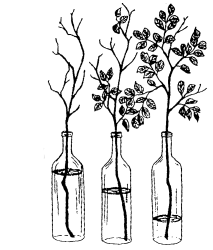|
|
Experiment
1
On a sunny summers day a big birch tree can give off as much as
450 litres of water through evaporation. Take a glass, put it upside
down on some grass in the sunshine. After a while you will notice
how water, evaporating from the soil and the grass, condenses to
form water drops on the inside of the glass.. |
 |
 |
Experiment
2
Water a potted plant. Put a plastic bag over it and place it in
the sun. Soon afterwards, you will find small drops of water on
the inside of the bag.TD>
| |
|
Experiment
3
Fill three bottles with an equal amount of water. In the first bottle
put a branch with no leaves; in the second, a branch with a few
leaves; in the third, a branch with a lot of leaves. Put some oil
on the water surface in each bottle to prevent evaporation. After
a few days, measure the water in each bottle. You will find that
most of the water has gone from the third bottle. Why is this so? |
 |
|


